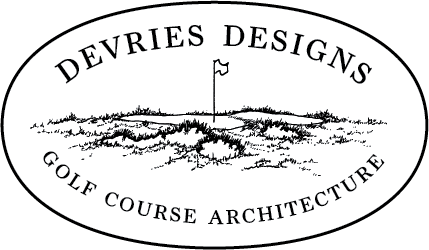Each golf hole is a study unto itself and, at the same time,
is an integral part of the collection of similar length holes,
the golf course, and the surrounding landscape. The key to great
golf course design is to provide for variety in length, direction,
angle of approach (uphill, downhill, sidehill), and hazards, and
to do so with a proliferation of options available to the golfer
according to his golf ability, both mentally and physically.
PAR 3'S
Mines Golf Course / Hole 7
Par threes are unique in that the architect is able to place the player in the exact spot that he wants the golfer to approach the green. This factor requires that the short holes have a diversity in length, hazard placement, and angle of approach to the green, whether uphill, downhill, or sidehill, in order to provide the diversity desired on the great courses. Often small, unique landforms in the landscape that would get lost in the expanse of the longer holes can be brought out in a par 3. Or an unattractive stretch between two holes can be created more economically into a good par three and strengthen the layout overall.
Diamond Springs / Hole 15
PAR 4'S
Par fours generally make up the majority of holes on a golf course and they have a great deal of variety in their collection due to the large difference in length for the two shotters.
Short par 4's look like easy birdies to strong players on the scorecard, but when well designed can actually give a boost to the weaker player who cannot reach the longer holes in two shots. If the 'tiger' does not place his approach correctly or takes a gamble in trying to reach the green on the drive, but fails, he may actually tie or lose to the lesser opponent who cannot hit the ball as far or sure. This can provide for a tremendous turn in a match and gives a psychological edge to the weaker player.
Long par 4's, on the other hand, can often play like short par fives. They are difficult for the better players and help to elevate the superior player who consistently makes his par. But the magnitude of the hole allows bogey to be a good score and for other players to leave satisfied.
Par fours give us the opportunity to develop great variety in the golf course. It is important to not eliminate any one segment from this collection. We must strive to get more diversity within the individual areas of short, medium, and long fours and to arrange them so that they relate with one another harmoniously.
PAR 5'S
Greywalls / Hole 1
Par fives are often the most difficult to design because there is a stroke in the middle which often does not relate to the beginning and end of the hole very well. The key to making the hole work is to challenge the golfer so that he may choose where his difficult shot must come in the play of the hole. A bold drive and / or second will set up the easy third versus the easy shot first with a more treacherous third to the green.
Short par 5's accentuate this by making the big hitter choose to "go for it" or lay up while the short, accurate hitter can often play his third tight and sink his birdie putt. It is another example of how great holes can be those that straddle the borders of the registered par.




